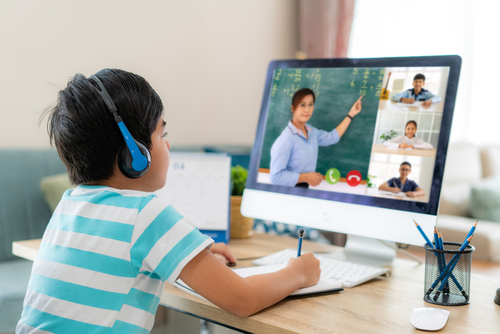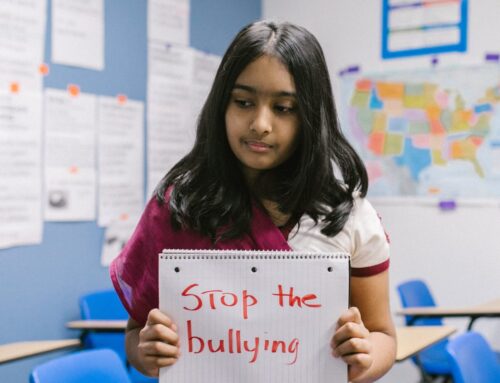The Brookings Institute reported devastating impacts during the pandemic on students and their ability to learn. In this interview Nicholas Carlisle speaks to Kate Sullivan, a seasoned 7th grade English Language Arts teacher in Durham, North Carolina and asks what it was like on the front lines of online learning provision during COVID. Kate shares her observations of the effect on students’ attention span and social skills. (Spoiler alert – seventh graders are at risk of becoming the new fifth grade.)
Nicholas Carlisle (NC): The past two years of Covid have impacted all of us, and particularly students who have been deprived of free and easy social interaction with their peers. Now that schools are returning to mostly normal classroom environments, what are you seeing as the effects of lockdown on your students?
Kate Sullivan (KS): So much has changed but I would say two things particularly standout.
Firstly, student attention spans, which were already deteriorating before Covid, are much more limited. If something is not fun, engaging or a tech based activity, it’s very hard to get students to sit, focus and work with integrity.
And then their social skills have been greatly impacted. 7th graders (mostly 12 and 13 year olds) must now be treated more like we would 5th or 4th graders. They are exhibiting rather immature behaviors like tattling on and touching others to annoy, or constantly getting up and running around. This is behavior that you wouldn’t expect in a middle school but we’re seeing much regressed social skills in a large majority of our students. They have found it difficult to connect with one another in terms of friendships and have face-to-face conversations. Things like group work are proving very difficult.
NC: These sound like significant setbacks. How are you working through them?
KS: To get them to interact constructively with their peers, I’m structuring to encourage them to start talking and interacting. This does not come naturally as they haven’t had these kinds of interactions for so long.
As for attention spans, we’re having to shift to an elementary school type schedule – switching topics and activities every 10 to 15 minutes to keep them engaged for whole periods. Before they could sit through an entire class and discuss, say a text or character analysis but now that’s really gone out of the window.
NC: Given your domain of teaching involves writing and literature, is this fragmentation of attention causing a decline in students ability to manage more advanced writing – for instance to absorb several paragraphs or concepts that require longer explanation?
KS: We are seeing many students struggling with writing, specifically spelling. At this point, I am working with all of my students, honors level included, on just writing a cohesive, structured paragraph. Nothing more. Longer writing assignments are not helpful.
NC: Have you seen this in some groups more than others?
KS: The challenges manifest in different ways depending on students’ situation during lockdown. Throughout online teaching, a large number of students were left on their own with many not attending online lessons and they lost all interest in school. There are always some students like that in a classroom but in pre-pandemic days, teachers had strategies to pull them back in. We are finding these students very hard to help. There’s a large group in my grade right now that spend most of their time in the disciplinary process because they cannot sit in a classroom, and it’s a much greater number than we would have seen before.
NC: Many are saying that the real pandemic we’re facing is that of failing mental health. I’m curious if you are seeing heightened student anxiety and depression levels and how that is playing out?
KS: Yes, students seem to be challenged a great deal with day-to-day anxiety and depression. I have students that really struggle because they can’t connect and share or be vulnerable with each other. Some students are very withdrawn and others are acting out in larger ways.
NC: Are they acting out in more aggressive or bullying behaviors?
KS: They weren’t in the beginning, but now, yes, there’s more and more of it. When they first came back it was like they were still in lockdown – classroom lockdown – where they were restricted to their desks and pods, not allowed to move. But as this is being relaxed we are seeing more bullying behavior and verbal bullying between the girls is really escalating.
Online bullying is also coming to the surface and working its way back into the classroom.
NC: In this context, and at this age, forming and sustaining friendships must be a challenge. This is extra concerning as strong relationships are the foundations of well being – buttresses against mental illness. When you look out at recess, do you see more students by themselves than in the past?
KS: Not in all cases, but definitely some. I eat lunch with a group of 30 students and see how they’ve evolved since the beginning of the school year. A couple groups have formed and they’ve figured out how to manage social challenges. Deep friendships are forming – which is very positive. At the same time, some students choose to self-isolate. One example – a boy with friends in class he’s known since elementary school, chooses to eat lunch on his own. He says he feels so much more comfortable alone. When other students say, “Hey come over here and sit with us”, he just says ‘Nope, I don’t want to’. Being back in the classroom is so overwhelming for him that at lunch time he prefers to go off by himself. There’s quite a few students who continue to isolate themselves – no matter how much you try to bring them in. One kid paces at lunchtime, back and forth, and that’s how he gets it all out. It’s very challenging, for us and for other students who want to pull them back in but don’t know how.
NC: As a teacher, it must be so hard to see that level of anxiety and distress these students are carrying.
KS: Yes, of course, but I’m lucky. My subject area is literature so I weave in social and emotional response questions to give them avenues of expression. And, if talking is too much, I use other techniques. One thing we do every six weeks is a game I call Crush Your Struggles. They anonymously write down on a piece of paper what they’re struggling with, scrunch it up and, all at once, throw them at me. I read them out one by one so everyone gets to hear everyone else’s struggles. Then we all get up and stomp on the pieces of paper. It’s become this thing that the students want to do because they can get things out and feel reassured hearing what the peers struggle with too. But some of this stuff is heart-breaking. The loneliness, the depression, not feeling like they belong. Some of this is typical for middle school years, but it has become so much more extreme after lockdown.
NC: Is it all down to lockdown do you think, or does social media play a part?
KS: I think it’s a combination. When I talk to colleagues – some who have taught for over 25 and seen it all – there’s consensus that social media plays its part, but things are much more intense since the pandemic.
It is particularly tricky – both socially and academically – with the current 8th graders who started their middle school years with the pandemic. Middle school is a big change from primary and they didn’t get the chance to properly transition into the new, more independent and socially interactive format. As such, we’re seeing those 4th/5th grade behaviors I mentioned before. It was a big struggle getting students to do school work during remote learning and now students are reluctant to join in during lessons. And with all the catching up to do, students are burned out – they just don’t want to do it.
NC: This is so concerning. If you were writing a ‘Post Pandemic Middle School Guide’, what would your recommendations be?
KS: There has to be a shift away from the heavy focus on testing and academic benchmarks, because, right now, they are unattainable. We have to take our foot off the academic gas pedal and, instead, devote time to building social and emotional skills on a daily basis. These students can’t handle five straight hours of sitting and doing focused instructional work. They need more movement during the school day and regular play time. Additionally, they need facilitated group conversations that allow them to talk about what they’re struggling with. All this will require much greater input from mental health experts. There are 1,200 students in my school and only three counselors. That’s simply not enough. And we’ll need those resources for the next year or even three. Not just for students but for teachers too.
NC: Tell me more about what you see as needed for teachers.
KS: Time. Teachers need a lot more time to meet the students’ needs. I do my planning on weekends and on my own time. There’s just not enough time in the work week to consider and manage all the changes and shifts. So many things have been thrown at us – instructional changes, keeping everyone safe, students separated, masks up. Above all, teachers need to be listened to. They are very, very tired. There has to be some thought into how to give teachers a break so they can come back refreshed.
NC: You’ve been through something monumental and now you’re being told to get back to business as usual. There’s been no real thought given to what you would need after a catastrophe.
KS: Exactly. As a colleague pointed out, no one’s done this before so the people in charge need to stop trying to pretend they’re experts and that they have everything under control. In our district, end of grade testing is being carried out the same as years before. As a result, we’re seeing the standardized test results declining across the board. We need to step back, reevaluate and start meeting the students where they are, not where we used to be.







Leave A Comment